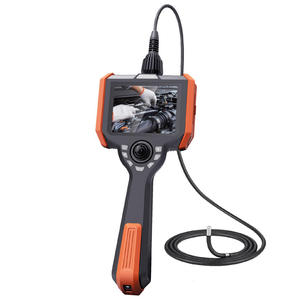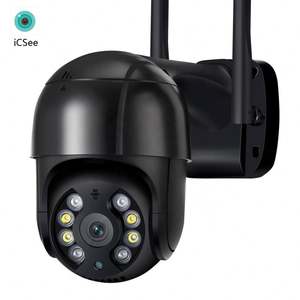CCTV Fiber: A Next-Generation Solution for Seamless Video Surveillance
Wiki Article
Exactly How CCTV Cameras With Fiber Optic Output Enhance Long-Distance Surveillance
CCTV video cameras equipped with fiber optic result stand for a significant advancement in long-distance security innovation, providing exceptional advantages over typical systems. By leveraging the residential or commercial properties of light transmission through fiber optics, these electronic cameras make sure high-definition video clip high quality remains undamaged across extensive ranges while effectively minimizing electro-magnetic interference - cctv fibre optic cable.
Comprehending Fiber Optic Innovation
Fiber optic technology is increasingly made use of in long-distance surveillance applications because of its outstanding capability for data transmission. This technology uses thin strands of glass or plastic fibers to transmit information as light signals, substantially decreasing the attenuation generally related to standard copper cable televisions. The inherent properties of optical fiber enable the transmission of large quantities of data over substantial distances without loss of quality, making it an excellent option for applications requiring trusted communication.The concept of overall internal representation facilitates the reliable transmission of light within the fiber, guaranteeing high bandwidth and speed. Unlike electric signals in metal cables, fiber optics are immune to electromagnetic disturbance, improving the honesty of data transmission. This particular is particularly beneficial in environments with high degrees of electrical sound, such as commercial settings or city areas.
Furthermore, fiber optic cables are lighter and a lot more flexible than their copper counterparts, which streamlines installation and minimizes structural tons. With their durability and resistance to environmental variables, fiber optics are appropriate for exterior applications, thereby prolonging the reach of checking systems. Consequently, fiber optic innovation is becoming a keystone in contemporary surveillance options, successfully resolving the obstacles of long-distance monitoring.
Benefits of Fiber Optic CCTV
Using fiber optic modern technology in CCTV systems offers countless benefits that enhance surveillance capacities. One of the key benefits is the ability to send high-def video clip over long ranges without considerable signal degradation. Unlike conventional copper wires, optical fiber can maintain video clip top quality over considerable runs, making them ideal for large residential properties or remote surveillance areas.In addition, fiber optic wires are much less prone to electro-magnetic disturbance, which can distort signals in conventional systems. This guarantees clearer images and uninterrupted solution, essential for protection surveillance. In addition, optical fiber are inherently more secure, as obstructing signals calls for specific devices, thus providing an added layer of security against unapproved accessibility.
The lightweight and small nature of fiber optic cable televisions also streamlines installation, making it possible for much easier routing via tight rooms and decreasing overall labor expenses. Their sturdiness makes them immune to environmental factors such as wetness and temperature changes, extending the life-span of the surveillance system.
Last but not least, fiber optic systems can support a better number of video cameras on a solitary network, optimizing sources and offering scalability for future growth. These advantages make fiber optic CCTV systems an exceptional selection for modern monitoring needs.
Comparison With Typical Systems
When contrasting CCTV systems, traditional configurations usually fall short in numerous key areas, specifically in terms of distance and signal honesty. Conventional coax systems commonly face considerable signal destruction over long distances, limiting efficient surveillance ranges to roughly 300 feet (cctv fibre optic cable). Yet limit, photo quality diminishes, resulting in possible blind places and reduced surveillance efficiencyOn the other hand, fiber optic systems preserve signal honesty over a lot better distances, frequently surpassing a number of miles without loss of high quality. This is greatly as a result of their ability to transmit data as this post light signals, which are less susceptible to electromagnetic interference than electrical signals used in conventional systems.
Furthermore, conventional systems need much more substantial maintenance and troubleshooting because of their vulnerability to environmental elements such as wetness and electromagnetic noise. Fiber optic systems, conversely, offer boosted durability and lower upkeep prices, as they are much less susceptible to damage.
Applications in Long-Distance Monitoring
The advantages of modern CCTV systems in maintaining signal integrity over lengthy ranges open a vast array of applications for long-distance surveillance. One considerable application remains in metropolitan monitoring, where towns deploy fiber optic CCTV systems to keep track of public spaces, boosting safety and security and hindering criminal task. These systems supply constant, premium video feeds that are essential for effective regulation enforcement and emergency situation reaction.An additional essential application is in industrial settings, where remote monitoring of producing procedures and unsafe areas is crucial. Fiber optic CCTV can withstand rough settings and transfer data over fars away without loss of high quality, permitting real-time oversight and minimizing threats to workers.
Additionally, critical facilities such as airport terminals, railways, and pipelines profit from long-distance More about the author CCTV monitoring. Safety and security groups can look after large areas from streamlined control areas, ensuring fast feedback to any events.
In addition, in farming settings, farmers utilize long-distance CCTV to keep track of plants and animals, aiding to enhance productivity and safety and security. Generally, the flexibility and reliability of fiber optic CCTV systems make them crucial throughout various industries, making it possible for thorough monitoring remedies tailored to details needs.
Future Patterns in Surveillance Technology
Exactly how will improvements in innovation improve the landscape of monitoring? The future of monitoring modern technology is positioned for considerable improvement, driven by advancements such as expert system (AI), artificial intelligence, and side computing. These technologies enable real-time information evaluation, permitting for rapid recognition of possible dangers and improved situational awareness.AI-powered analytics will boost the precision of facial recognition systems, lowering incorrect positives and allowing more reliable monitoring of individuals. Furthermore, the assimilation of Web of Things (IoT) tools will certainly help with a smooth network of interconnected security systems, improving monitoring capacities across substantial locations.
One more fad is the shift in the direction of cloud-based storage solutions, which use scalable data administration and ease of discover this access. This will certainly allow companies to store huge amounts of video information without the limitations of physical storage space, while ensuring that details is easily retrievable.

Verdict
Finally, CCTV electronic cameras geared up with fiber optic result represent a considerable advancement in long-distance tracking capacities. The utilization of fiber optic modern technology ensures high-definition video clip transmission over extensive distances without top quality deterioration, while additionally offering resistance to electro-magnetic interference. The lightweight and versatile nature of these systems facilitates streamlined setup and source optimization. As surveillance innovation remains to evolve, the adoption of fiber optic services will likely play a crucial duty in enhancing safety and security throughout varied applications.Report this wiki page